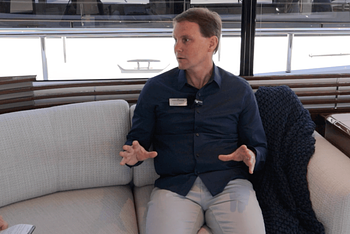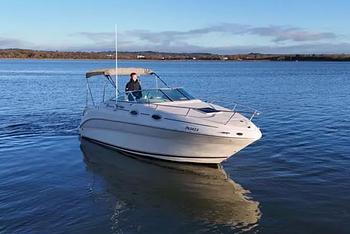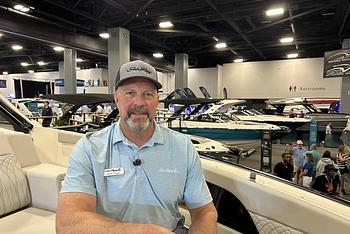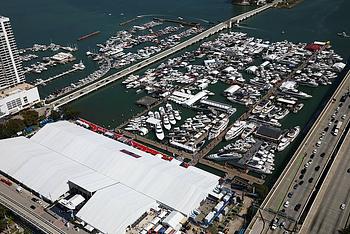For the last 30 years, Staley Weidman has been focused on catamaran sales and charter. When he joined The Catamaran Company 21 years ago, he became the top-selling broker, and for the last eight years he’s been CEO, based in Ft. Lauderdale. Last month, he spoke with Rightboat.com content director John Burnham on the day after the Ft. Lauderdale International Boat Show.

Staley Weidman
John Burnham
Thanks for joining me to talk about the catamaran market for people who go to Rightboat.com shopping for catamarans. Let’s start with some perspective. When you look way back, what would you say was the tipping point when catamarans moved from being in a fringe part of the market to a core sector?
Staley Weidman
We started to feel that the catamaran range was getting into the mainstream around 2001. There were a number of things that were happening. There were some new models being introduced: Lagoon had just introduced their 380, which was a huge success as an entry level sailing catamaran. And the Moorings previous to that had been using the Lagoon 37 and 42 in charter, and they had some very good success with that. Then they walked into a venture with a South African company called Robertson & Caine and started producing a 45-foot sailing cat, and then a 38. Having those boats in the world's largest charter fleet got those brands and those models a lot of exposure and charter companies started to take on a few cats.
Before I started with the Catamaran Company, I was with a company called Sun Yacht Charters, and we had a partnership with Stardust Marine, a large French company. They also started working with a company out of South Africa called Voyage, with a model called the Norseman 430. And that boat caught on quite well. It was a good-looking boat, it sailed great, it was a little bit Spartan on the inside, but it fit the right mindset.
That sort of perfect storm of things happening together really pushed the sailing catamaran market into the mainstream at a time when you would attend a boat show and see loads of monohulls and just a few cats, usually on the outside docks. By comparison, a couple weeks ago at the Annapolis show, you walked down the dock and it was almost entirely sailing cats.

Lagoon model catamarans such as the Lagoon 380 have been key drivers in moving catamarans into the market’s mainstream. All photos by The Catamaran Company.
Burnham: When did power-cats make their big move?
Weidman: In 2010, we started to see the power-cat market evolve. Once again, the Moorings started out with a line of Leopard 47 power-cats that got those boats into the market. And Lagoon, with a 43 power-cat that sold 127 hulls, although they really didn't view it as a successful range for them in comparison to their sailing cats. Then Aquila—MarineMax owns the brand—started with a 44 and a 48 and placed them in charter at their own charter base in the BVI. The Aquila 44 had a very accommodating 3 cabin layout that was a hit. They also started distributing those models through their stores on the Eastern Seaboard. While they had a pretty slow start in 2014-2015, they’ve now enjoyed tremendous success with that range going all the way from 28 feet to 70 feet.
That pushed the power catamaran market, and then we saw Fountaine Pajot very successfully come out with several powercats, as did luxury catamaran builders like Sunreef, who we started a relationship with in 2003. It was a monumental move getting catamarans into the big luxury yacht range, where they weren't viewed as smaller charter boats or smaller recreational boats but as really high-end, luxury yachts. Sunreef came up with a whole line from 50 to 100 feet. They’ve done a tremendous job and built well over 200 boats with a huge facility. One of the directors in the company told me yesterday at the Lauderdale boat show that they currently have 2400 employees working in three separate shipyards. That’s pretty impressive for a company that was building five or six boats a year, 10 years ago.
Burnham: What should buyers be thinking about when looking at the market today? Any great deals out there?
Weidman: No, there aren’t any real great deals out there in the pre-owned market. Traditionally, people have looked at ex-charter boats as good value because they've got higher use cycles and higher engine hours and show more signs of wear in a short period of time. So that's always generated a lot of interest, where people feel like they can get into a bigger, newer boat for less cost than what they would pay in the private market.
But our advice to clients is to stick with name-brand manufacturers, because they have very high resale, and they're easier to transact out of when you’re ready to move on. We also recommend staying with newer boats. Just from four years ago to today, there are light years’ difference in the systems on the boats.
If a client can identify a model or a layout as a preference in the pre-owned market, the best value for them is to find as late-model a boat as they can afford to purchase, because you're going to be getting the latest technology, the components are likely to still be supported, and/or replacement parts available. I think they're going to enjoy the boat more, it's going to be more efficient, look nicer, be more comfortable, and perform better.
The Catamaran Company charter base in Hodges Creek, Tortola, is one of few 5-star charter bases in the BVI and features a fleet of charter catamarans with more amenities included than any bareboat fleet on Tortola.
Burnham: OK, same advice with power-cats?
Weidman: Yes. The innovation in both of those segments of the market is progressing along, and when each one of these builders comes out with a new model, it's a huge step. We’re also seeing more power manufacturers get into the power-cat market, bringing new models to market, and some that are exclusively building power-cats. In the smaller range, you've got companies like WorldCat building hundreds of boats and companies like Freeman building really exceptional center console style fishing boats, as well as traditionally monohull builders like Invincible and Sea Hunter.
Even traditional monohull builders are building catamarans, like Horizon with a line from 52ft to 74ft and Prestige, for example, has a new 48 power-cat model out that's a very nice looking boat. Even smaller companies like Four Winns have a power-cat model out to compete with Aquila.
Looking to the future, we’ll see a lot of the main sailing cat builders continue on, but in the power-cat range, I would say the next two to three years will see many more offerings in power-cats coming from builders that you wouldn't expect.
Burnham: You got into the boating industry as a sailor and sailing was key to the development of the catamaran segment. Power-cats are doing that too. Is anything holding them back?
Weidman: The market is driven by market demand from what the customers feel like they want. And it's also driven by innovation where new products and brands come to market promising different things. And a lot of it is simply styling. When you have a boat that looks great, and performs well, you've got a home run in the market, assuming it's not priced in the stratosphere.
What people are looking for is innovation: what is the power-cat going to do that their conventional powerboat or powerboat brands don't. As people get exposure to newer models, they're discovering that the boats have extremely good economy. So for the same size boat, you're putting in smaller engines, smaller fuel tanks, enjoying better economy, and longer range than what you'd expect in a monohull.
You've also got the undeniable volume for the same length overall; you've got the ability to have these enormous salons in the boat. And there's the ride: they're very stable, they don't pitch and roll and rock. People ask me about adding stabilizer fins and gyro stabilizers like a Seakeeper. The truth is, they're just not needed with this type of hull design.
I think these things are becoming imprinted in the consumer’s minds as to what a powercat represents. And I feel when you add that up, and anytime there's a spike in fuel prices, it really gets people's attention.
There's also a lot of innovation going on. You know, the latest trend that we're seeing right now in the industry is the electrification of propulsion systems. In the Sunreef line, for example, they have their Eco line, which are cats that have a solar skin that's very innovative, and huge battery banks that weren't available before, or weighed too much, or took up too much space, or were cost prohibitive. And now the cost has come down a and the battery power that's available with these systems is something people aren't even aware exists. When I talk to powerboat clients, and I tell them we have a boat that you can be offshore on all night and not run the generator, they don't even think that's possible. With these Sunreef Eco boats, like the Eco 80 we delivered to our client and exhibited at the Fort Lauderdale Boat Show, the boat can run all the systems on it except for propulsion for a week without any input from shore power, solar, or generator. That's just from the battery bank. People don't even think that's possible, but we're doing it right now.

Pier Seven Resort Marina is a catamaran-centric marina in Annapolis, Maryland, owned by The Catamaran Company. It’s one of three marinas in the state owned by the company to better serve all area catamaran buyers.
Burnham: You’ve been representing the owner in the Sunreef 80 Eco build for a couple of years now. What are your top takeaways?
Weidman: As far as meaningful innovation in that market segment, the Eco boats are here, and Sunreef has more orders for Eco versions of their boats than those with conventional diesel power. That's across the board, both in their sail and power-cat ranges. In the future, you're going to start to see even better battery technology coming into the market. You’ll start to see hybrid power where electric propulsion becomes extremely valuable—when you're going short distances, or going slowly, like on the Intracoastal Waterway, or as a fishing boat trolling, or maybe when the weather's rough and you're going slower anyway. I feel that the combo, with a smaller, more efficient diesel engine and the ability to have an electric motor coupled to that propulsion system where it's in ECO mode—at that point you're going to be running on electricity or battery power. This is the planned propulsion system for the new Sunreef Ultma 55 and 88 we are taking orders on now.
For higher load or higher speeds, you have the diesel engine kick in. The applications I've seen through several companies like MAN and VW and Caterpillar have an augmented hybrid system with a smaller-than-normal diesel. Instead of having a lot more fuel consumption and a bigger engine, the electric motor will simply kick in, providing a boost to either hit the higher speeds, or provide longer, more sustainable fuel economy at cruising speeds.
We've seen applications where the motor is either in line with the output shaft or the electric motor is coupled to an input shaft on the side of the transmission, where it can add additional thrust and torque to the propulsion system when it's operating under diesel. Then when it's motoring on diesel only, it still engages and turns the electric motor to create a generator effect and put power back into the battery banks.
So I think there's a lot applications there. Fishing boats and outboards are likely to see a huge benefit from that. I mean, let's face it, as big as these fishing boats are whether it's a center console or a sport fish, when they're out fishing they're rarely doing over eight knots. And the electric propulsion is extremely efficient at that power range.

Staley Weidman, CEO of The Catamaran Company, presents the Sunreef Eco 80 Power at its debut at the Sunreef exhibit during the Fort Lauderdale International Boat Show, Oct. 2023.
Burnham: So what's the impact going to be on you when you buy the boat of your dreams?
Weidman: Well, I don't know if that exists, but it's probably coming in the near future. You know, I'm more of a fishing and diving kind of guy and I live here in Fort Lauderdale. So the ability to get out quickly and go to the Bahamas to fish and dive there and come back has a lot of appeal to me. I think these faster center console power-cats are really doing the job now. And when Mercury, Yamaha, Suzuki and other outboard manufacturers start coming up with some hybrid outboards that burn less or no fuel—and maybe foil as well and work a little more efficiently through the water—then we'll really have something to interest me personally.
To learn more about the Sunreef Yachts Eco 80 Powercat, follow the documentary series underway at The Catamaran Company Youtube channel. The headquarters for The Catamaran Company is in Ft. Lauderdale, Florida, with more than a half dozen other offices spread throughout the U.S., U.K., and the Caribbean.





